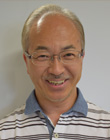Top>Education>Cultivating Students who Investigate the Mysteries of Life and the Environment —Based on Activities as a Super Science High School (SSH)
Cultivating Students who Investigate the Mysteries of Life and the Environment
Based on Activities as a Super Science High School (SSH)
Hiroyuki Okazaki
Teacher of Bioscience, Chuo University Junior and Senior High School
Areas of Specialization: Zoo-ecology, Biological science education and Science education methodology
The Chuo University Junior and Senior High School was designated as a Super Science High School (hereinafter, “SSH”) in April of 2018. The purpose is to develop educational programs which reflect current trends, based on the educational activities of our school (hereinafter, “Chufu”) so far. I often hear the following questions—“I thought Chufu was a school of humanities, so why are you designated as an SSH?” “After the designation as an SSH, what is going to change?” In this article, I will explain about Chufu’s initiatives as an SSH, as well as the educational activities that I currently conduct and plan to conduct in the future.
Chufu’s purpose and initiatives as an SSH
The SSH program was started by the Ministry of Education, Culture, Sports, Science and Technology in the 2002 academic year. By cultivating students’ scientific abilities and scientific thinking abilities through advanced education in scientific technology, science and mathematics, this program aims to foster scientific technology human resources that will play leading roles in future global society. It also aims to cultivate passion and dreams for enjoying science, as well as to develop children’s personalities and abilities.
Chufu’s research and development theme as an SSH is to develop educational curriculums to foster scientific technology human resources who will support next-generation innovation and succeed after enrolling at university. We have established the following three goals: (1) by guiding students in their research tasks for several years, we seek to improve the abilities and attributes required in scientific technology human resources who support next-generation innovation, (2) we seek to enhance the internationality of students through the development of Project in English III, a subject that fuses English and science, and (3) we seek to develop a competency based evaluation system; to evaluate and guide students in not only knowledge, skills, thinking ability, judgement and expression, but also in inner attributes such as motivation to learn and human nature; and to cultivate scientific technology human resources who will flourish after enrollment at universities. Specifically, in their first year of high school, they listen to the lectures of researchers in various fields. In their second year of high school, according to their individual interests, they work on a research theme by selecting one of the four nature science subjects in the course Project in Science I. The available subjects are “Investigation of the natural environment and development of tourism resources in Langkawi Island (Training in Malaysia),” “Consideration for learning through mathematics and English (Training in Canada),” “Sports training (Training in Japan),” and “Programming (Training in Japan).” We will start “Trans-science science and its history” as a subject of SSH in the 2019 academic year. For the subject, we plan to structure classes based on the theme of how scientific technology has developed in Japan and what related issues are raised, from the perspectives of both the humanities and science. For example, the subject will examine issues such as the Fukushima nuclear accident and military bases in Okinawa. In their third year of high school, students conduct graduation research in science and write reports in Project in Science II. During this research, they can receive advice from not only high school teachers but also from professors in the Faculty of Science and Engineering in Chuo University. Attendance of springtime classes and presentation of graduation research are held in the Faculty of Science and Engineering in Chuo University. In Project in English III, students use English to learn about science. This improves their practical English so that they can perform competently at international conferences and conventions. Since the 2018 academic year, we have increased our level of cooperation with the Faculty of Science and Engineering in Chuo University. In addition to performing graduation research at Chuo University, we also conduct research on competency based evaluation system. In the next section of this article, I would like to introduce our present education activities.
Development of courses which fuse different subjects
Students who major in science choose two subjects from physics, chemistry and biology in their third year of high school. We also provide classes which fuse physics and biology in specific fields. One example is the fusion of the optics field in physics and the photoreceptor (structure and functions of eyes) field in biology. In this class, students selecting physics and students selecting biology study in the same classroom. Our eyes function by refracting lights with a convex lens called a crystalline lens. The resulting image is then reflected in the film called a retina. Students study the properties of convex lenses through physics experiments. They learn that an inverted image is seen and that the lens must be moved back and forth to adjust focus. However, our eyes don’t move our lens back and forth to adjust the focus—so how are we able to adjust the focus? Actually, our eyes can change the thickness of the crystalline lens. This is possible because the lenses of our eyes are made from a special protein. The image which we see is reflected in the retina upside down, but we see the image normally because of the function of our cerebrum. While experimenting, we develop lessons which use an active-learning style such as group discussions and exchanges of opinions. Moving forward, we will gradually develop science fields (units) for fusion, as well as subjects for fusion.
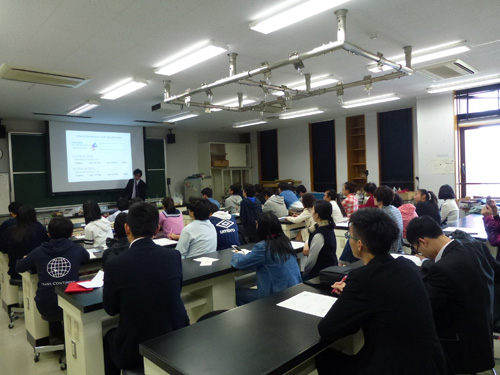
Students listen attentively during a class which fuses physics and biology
Experiment camp
Chufu holds an experiment camp for students (applicants only) in their third year of high school during summer vacation and post-exam vacation. The two-day camp allows us to perform experiments and observations which are too time-consuming for normal classes. The camp is held at school with shower facilities available. Students are able to conduct experiments and solve problems together late into the night. Some examples in the field of biology are as follows: students dissected pig eyes, extracted DNA from vegetables, experienced how eating chocolate while drinking Gymnema causes the sense of taste to change, experienced how lemons taste sweet after eating miracle fruits, and observed nocturnal animals throughout the night. In 2018, each student used sea urchin sperm to fertilize a sea urchin egg, and then spent many hours using a microscope to observe how the shape of the creature was formed from the fertilized egg. Somatic cell division after fertilization is called cleavage. Students observed a living cleavage. I’m sure that students were thrilled to witness the process in which a single cell consisting of a fertilized egg divided into two, four, and then eight cells. The laboratory was open all night and some students struggled to keep their eyes open while observing the cells into the early morning hours. Since our school was designated as an SSH in the 2018 academic year, it is now possible for students in their first and second year of high school to participate in the camp.
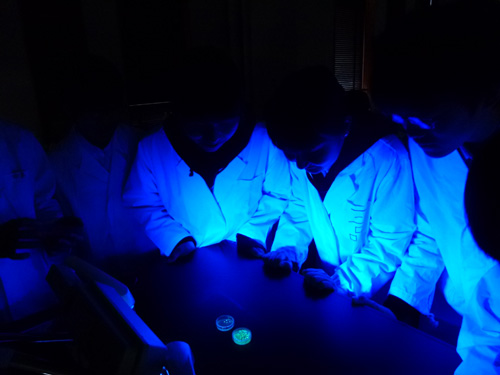
Students conduct an experiment on genetic recombination
Activities of the Wildlife Club
I am an advisor of the Wildlife Club. We mainly conduct biological research on wild animals found at Mount Takao and the hills in Ome. For example, we research giant flying squirrels at Mount Takao, and badgers, raccoon dogs, and foxes in Ome. Club members climb Mount Takao once or twice a month in order to research giant flying squirrels that appear from their burrows 30 minutes after sunset. We researched what they ate throughout the year, factors for determining their preference of what leafage they eat, and how long they behave as a nocturnal animal. We found that their preference of leafage is related to amino acids which indicate the sweetness and flavor included in the leaves. Our club presented these results at a meeting of the Society of Evolutionary Studies, Japan held at Kyoto University in the 2017 academic year. We received the highest award in the category of high school student posters. When researching the activities of giant flying squirrels, we developed our own sensor and found that squirrel activity peaks twice per night. By doing so, we demonstrated that nocturnal animals are not constantly moving all throughout the night. We presented these results at a meeting of the Ecological Society of Japan in the 2016 academic year and received the Grand Prize. The ability to read a map is a necessary skill when conducting biological research outside. Therefore, our club holds an orienteering competition in which students use a map to search for points set on a hill and set their own course. We competed in the Tokyo championship, the national tournament, and an inter-high school competition, and won a lot of prizes. Although our club is designated as a cultural activity, it is actually closer to an outdoors club. Students in the Wildlife Club start to learn orienteering after enrolling at Chufu. A female graduate from our club became a representative of Japan at ski orienteering competitions in university. She participated in international tournaments including a tournament held in Estonia in the 2017 academic year, and tournaments held in Russia and Sweden in the 2018 academic year.
We also started to survey and research coral from the 2018 academic year. After receiving grants from the Nippon Foundation for our marine educational program and being designated as an SSH, we were able to acquire a tank for growing coral. We will use sensors to investigate water quality necessary for growing coral, and will research the growth and ecology of coral. Some students majoring in science are conducting graduation research on coral in their third year of high school. During summer vacation, we travel to the island of Kikaijima in Kagoshima Prefecture, in order to conduct research while receiving advice from the KIKAI Institute for Coral Reef Sciences.
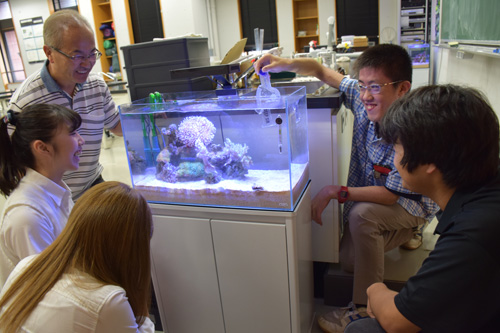
Students grow and research coral in the biology laboratory
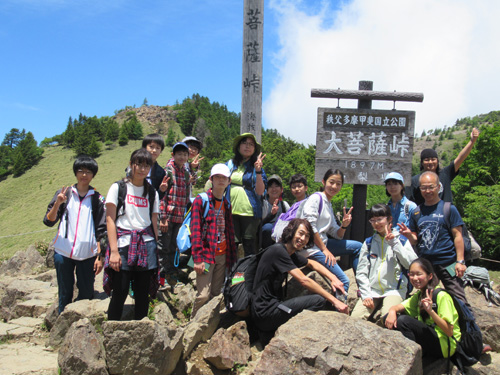
Observing nature in the mountain pass of Mount Daibosatsu
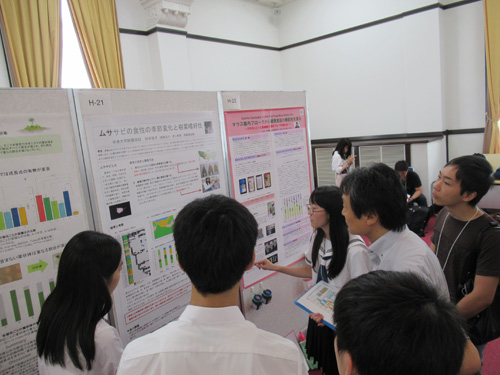
Presenting research results on the feeding habits of giant flying squirrels at the Society of Evolutionary Studies, Japan
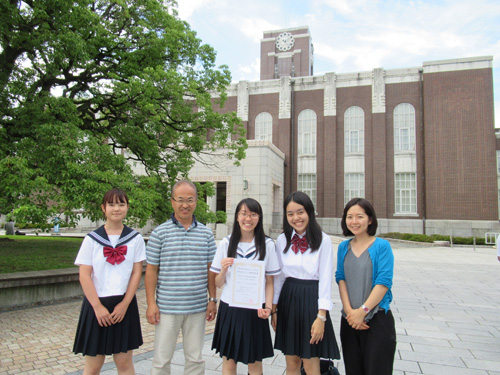
Students won the highest award in the high school student poster category at a meeting of the Society of Evolutionary Studies, Japan
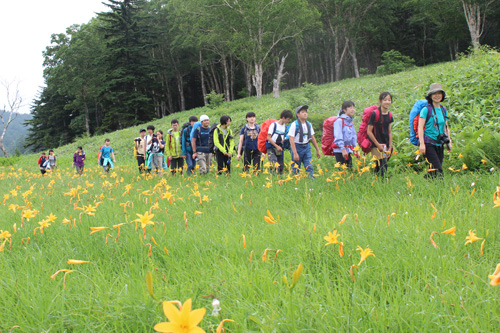
Summer camp in Oze
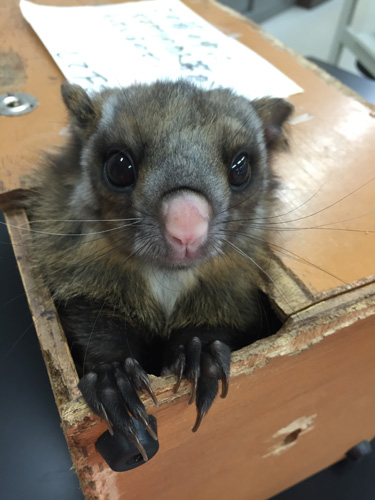
Our giant flying squirrel Gururu made great contributions to our research!
Project in Science I: Investigation of the natural environment and development of tourism resources in Langkawi Island
A coral restoration program is performed on Langkawi Island (located in northern Malaysia) by students who select Malaysia for Project in Science I in their second year of high school. This program aims to restore coral that was destroyed by a tsunami resulting from a massive earthquake in Indonesia. Since last year, the program has been conducted while receiving guidance from local professors during study tours in Langkawi Island. Another project on Langkawi Island is to observe mammals that live in tropical rainforests; for example, the dusky leaf monkeys, crab-eating monkeys, slow lorises, flying lemurs, giant red flying squirrels, dwarf flying squirrels, and wild boars. We also observe birds such as the hornbills, brahminy kites, sea eagles, and collared kingfishers, as well as lizards such as the Malayan monitor lizards and Tokay geckos. Additionally, we observe the rainforest itself and a geopark. Furthermore, we travel by kayak in order to observe life in mangrove forests. At fish farms, we see horseshoe crabs and archerfish, and we observe bats in limestone caves. From the 2018 academic year, in addition to observation, we aim to interact with local high schools and to create a pamphlet summarizing the results of our surveys. In the future, I hope to arrange survey research performed together with high school students from Langkawi Island and a presentation given to the Japan National Tourism Organization.
In this article, I introduced past initiatives and future initiatives made possible through designation as an SSH. Due to limited space, I was only able to introduce a portion of our activities. “We’re so busy, but it’s a lot of fun!”—Many of my students feel this way. SSH initiatives have just begun at Chufu. Moving forward, I intend to conduct further review, develop an even more appealing curriculum, and work to cultivate human resources with rich creativity. I encourage more students to experience SSH initiatives which are only possible at a university-affiliated high school.
Please join us and enjoy science!
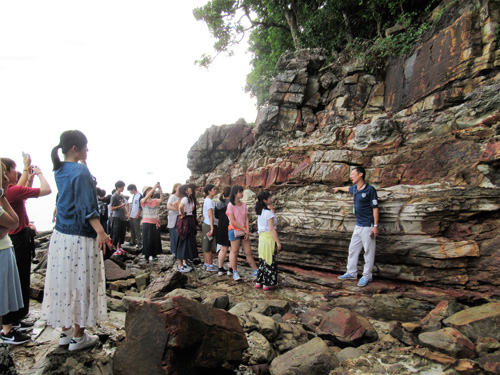
Observing a geological stratum from 550 million years ago
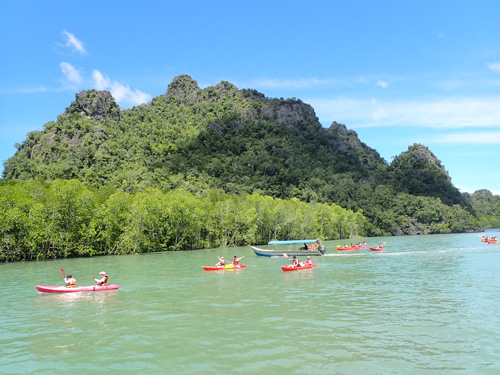
Observing nature in a mangrove forest
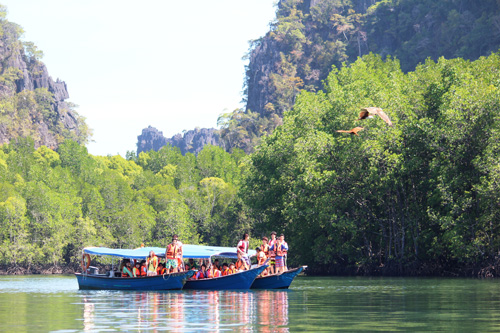
Observing eagles and hawks from boats
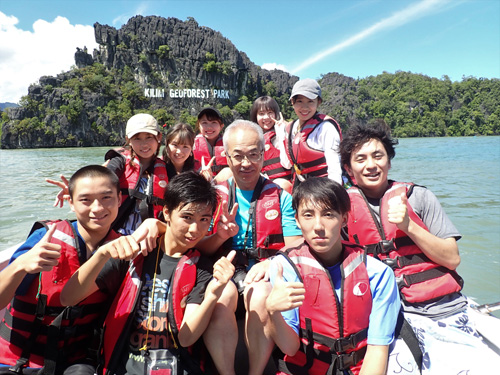
Together with my students at Kilim Karst Geoforest Park. The park possesses important geological characteristics.
- Hiroyuki Okazaki
Teacher of Bioscience, Chuo University Junior and Senior High School
Areas of Specialization: Zoo-ecology, Biological science education and Science education methodology -
Hiroyuki Okazaki was born in Tokyo in 1958. He graduated from the College of Biological Sciences, the University of Tsukuba, and completed his Master’s Degree in science education in the Graduate School of Education, Tokyo Gakugei University. After teaching at a high school in Tokyo for 25 years, he assumed his current position in 2009. Previously, he served as an instructor of biology for high school classes held by NHK (1994 to 2008). He started giant flying squirrel research in his university days and has climbed Mt. Takao more than 1,000 times.
His current research topic is the relationship between giant flying squirrel distribution and environmental factors. He conducts giant flying squirrel and wildlife investigations with his students in the mountains and hills of Tama district, and is called Musasabi Sensei (giant flying squirrel teacher) by his students. Awards he has received include 2003 Tokyo Shimbun Education Award, 2007 Tokyo Metropolitan Board of Education Staff Award and 2008 Ministry of Education, Culture, Sports, Science and Technology Outstanding Teacher Award. He is a member of the Risu Musasabi Network of the Mammal Society of Japan and the Society of Biological Sciences Education of Japan.
Major publications include I Want to Meet a Giant Flying Squirrel! (Shobunsha, 2004), Mysteries of Tokyo Encyclopedia (coauthored, Shinjinbutsu-oraisha, 1997) and Everyday Wildlife Encyclopedia (coauthored, Tokyodoshuppan, 1998).
- Research Activities as a Member of Research Fellowship for Young Scientists (DC1), Japan Society for the Promotion of Science (JSPS) Shuma Tsurumi
- Important Factors for Innovation in Payment Services Nobuhiko Sugiura
- Beyond the Concepts of Fellow Citizens and Foreigners— To Achieve SDGs Goal 10 “Reduce Inequality Within and Among Countries” Rika Lee
- Diary of Struggles in Cambodia Fumie Fukuoka
- How Can We Measure Learning Ability?
—Analysis of a Competency Self-Assessment Questionnaire— Yu Saito / Yoko Neha - The Making of the Movie Kirakira Megane

-
Newest Edition 2019 Autumn Issue
Student journalists report on the students’ take of Chuo University

-
Chuo-DNA
The school's history and motto have been passed on to graduates and students alike. Here is a visualization of Chuo University in the future.Core Energy
Launching Chuo University's Knowledge into Action to the rest of the world, like an infinity of sparkling stars scattered throughout space.
Planned by The Yomiuri Shimbun Business Bureau [PR]








